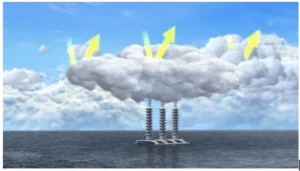
Why in news?
As global warming tightens its grip, scientists are exploring unconventional solutions to cool the planet. One such method, grabbing headlines recently, is Marine Cloud Brightening (MCB).
What is Marine Cloud Brightening?
- Imagine painting the sky with a giant whitewash brush. That’s essentially the idea behind MCB.
- It involves spraying tiny seawater droplets into specific clouds, aiming to make them brighter and more reflective. These targeted clouds are marine stratocumulus clouds, prevalent over vast stretches of the ocean.
- The science behind it hinges on the role of aerosols – tiny airborne particles.
- Existing air pollution releases aerosols that, when mixed with clouds, can increase their reflectivity.
- MCB proposes mimicking this effect by introducing benign materials like sea salt to enhance cloud brightness.
Goals of Marine Cloud Brightening:
- Scientists are primarily driven by two goals:
- Understanding current effects: MCB research seeks to shed light on how existing pollution aerosols influence clouds. This knowledge is crucial for accurately modeling future climate scenarios.
- Combating near-term warming: MCB could potentially act as a temporary cooling mechanism while we work on reducing greenhouse gas emissions to safer levels. This “buy us time” approach could be crucial as we transition to a low-carbon future.
Aerosols and the Climate Effect:
- Air quality regulations are leading to a decline in aerosol concentration.
- This, ironically, contributes to global warming because most aerosols have a cooling effect – they reflect sunlight back into space.
- Scientists estimate this offsets roughly 0.5°C of warming, with some uncertainty around the exact value.
- MCB aims to replicate this cooling effect by introducing controlled amounts of sea salt aerosols, potentially mitigating some of the current warming trend.
Challenges and Risks of MCB:
- While the idea is captivating, marine cloud brightening faces significant hurdles:
- Technical Feasibility: Spraying large volumes of seawater at high altitudes requires complex engineering solutions. Designing, deploying, and maintaining these spraying devices comes with considerable costs.
- Environmental Impacts: Altering cloud patterns and precipitation could disrupt regional climates and hydrological cycles. Unforeseen consequences like droughts or floods could arise. Changes in cloud cover over vast areas can affect atmospheric circulation, weather patterns, and precipitation far beyond the initial brightening zone.
- Ethical Concerns: MCB raises serious ethical questions about manipulating natural processes. Who governs such interventions? Who decides when and where to implement them?
- Moral Hazard: MCB might lead to a dangerous mindset. Policymakers and the public could become complacent, delaying crucial efforts to reduce emissions and adapt to climate change.
Conclusion:
- Marine Cloud Brightening is a nascent technology with immense potential benefits and significant risks. While it’s not a substitute for reducing greenhouse gas emissions, it could be a valuable tool in the fight against climate change.
- However, extensive research and international dialogue are essential before considering large-scale deployment.
- Sustainable adaptation strategies remain the most viable path forward.
- MCB, if pursued, needs to be accompanied by a strong commitment to emissions reduction and a clear understanding of the potential consequences.
- Only through rigorous scientific exploration, open discussions, and responsible decision-making can we determine if MCB is a ray of hope or a Pandora’s Box.
People also ask
Q1: What is Marine Cloud Brightening (MCB)?
Ans: Marine Cloud Brightening is a proposed geoengineering technique that involves spraying tiny seawater droplets into marine stratocumulus clouds. This aims to increase the clouds’ reflectivity, reflecting more sunlight back into space and potentially cooling the Earth.
Q2: How does MCB work?
Ans: Clean marine air has relatively few cloud condensation nuclei (CCN), tiny particles around which water vapor condenses to form clouds. MCB proposes adding more CCN, like sea salt particles, to create denser clouds with smaller droplets. These smaller droplets reflect sunlight more efficiently, making the clouds appear brighter.
Q3: Isn’t spraying things into the air bad for the environment?
Ans: While traditional air pollution aerosols can have negative effects, MCB uses natural seawater. However, altering cloud patterns could have unintended consequences, like disrupting regional climates and rainfall patterns.
Your point of view caught my eye and was very interesting. Thanks. I have a question for you.
Thank you for your sharing. I am worried that I lack creative ideas. It is your article that makes me full of hope. Thank you. But, I have a question, can you help me?